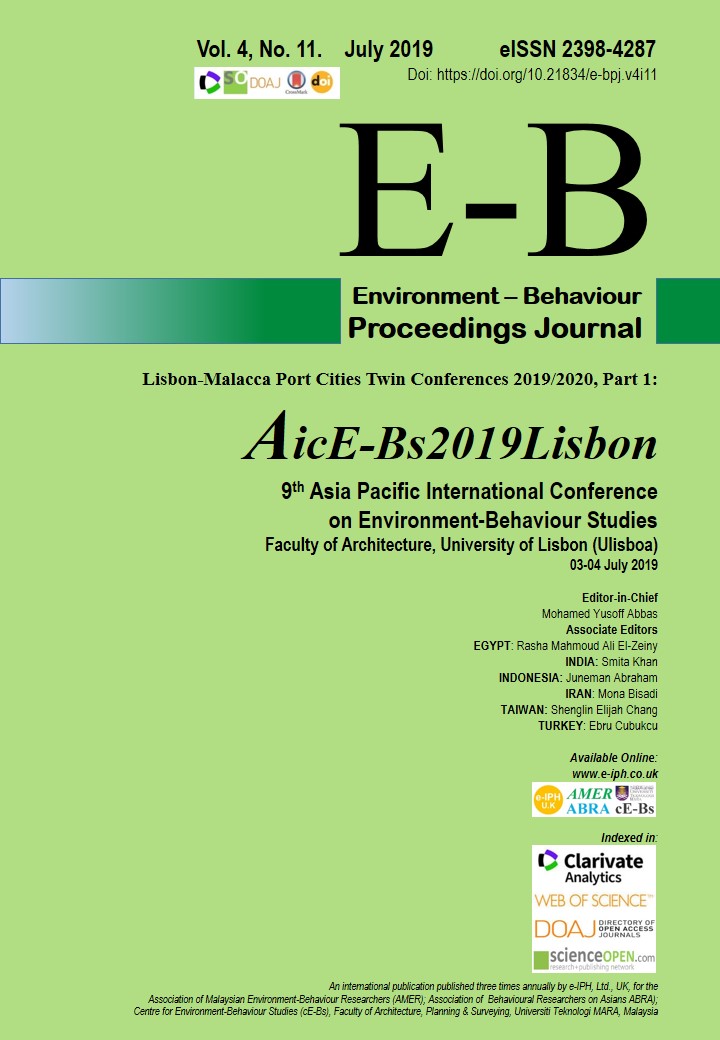Re-evaluation of the conceptualisation of super levees by focusing on the availability of open space as an evacuation area along the Arakawa River
DOI:
https://doi.org/10.21834/e-bpj.v4i11.1757Keywords:
super levee, open space, flood, evacuationAbstract

The objective of this study is to re-evaluate the conceptualisation of super levees by focussing on the availability of open spaces as evacuation areas along the Arakawa River. By using land use analysis, occupation analysis and cross-section, this study found that open spaces on super levees able to accommodate a large number of evacuees. This proves that the development of super levees is undeniably ready to provide sizeable safe upland evacuation area for nearby residents. This study also implies that the future development of super levee should include more open space by the development of a public park on the site.
Keywords: super levee; open space; flood; evacuation
eISSN: 2398-4287 © 2019. The Authors. Published for AMER ABRA cE-Bs by e-International Publishing House, Ltd., UK. This is an open access article under the CC BYNC-ND license (http://creativecommons.org/licenses/by-nc-nd/4.0/). Peer–review under responsibility of AMER (Association of Malaysian Environment-Behaviour Researchers), ABRA (Association of Behavioural Researchers on Asians) and cE-Bs (Centre for Environment-Behaviour Studies), Faculty of Architecture, Planning & Surveying, Universiti Teknologi MARA, Malaysia.
References
References
Allan, P., & Bryant. (2010). The critical role of open space in earthquake recovery: a case study. EN: Proceedings of the 2010 NZSEE Conference, 1-10.
Arakawa-Karyu River Office. (2007). Super levee guidebook. Tokyo, Japan: Author.
Arakawa-Karyu River Office. (2017a). Briefing material - super levees. Tokyo, Japan: Author.
Arakawa-Karyu River Office. (2017b). Guide for the visit to the Arakawa River. Tokyo, Japan: Author.
Geospatial Information Authority of Japan (GSI). (2019). [map]. Retrieved from http://maps.gsi.go.jp/#5/36.104611/140.084556/&base=std&ls=std&disp=1&vs=c1j0h0k0l0u0t0z0r0s0m0f1
León, J., & March, A. (2014). Urban morphology as a tool for supporting tsunami rapid resilience: A case study of Talcahuano, Chile. Habitat International, 43, 250-262. doi:10.1016/j.habitatint.2014.04.006
Luo, P., He, B., Takara, K., Xiong, Y. E., Nover, D., Duan, W., & Fukushi, K. (2015). Historical assessment of Chinese and Japanese flood management policies and implications for managing future floods. Environmental Science & Policy, 48, 265-277. doi:10.1016/j.envsci.2014.12.015
McKean, C. A. (2013, December 4). Tokyo building enormous “super levees†to hold back its river. NextCity. Retrieved from https://nextcity.org/daily/entry/tokyo-is-building-enormous-super-levees-to-hold-back-its-river
Ministry of Land, Infrastructure, Transport and Tourism. (2017a). Current status of high standard levee. Retrieved from http://www.mlit.go.jp/river/shinngikai_blog/koukikaku_kentoukai/dai1kai/pdf/2-1_genjyo.pdf
in Japanese
Ministry of Land, Infrastructure, Transport and Tourism (MLIT). (2017b). Towards the promotion of efficient maintenance of high standard levee. Retrieved from http://www.mlit.go.jp/river/shinngikai_blog/koukikaku_kentoukai/teigen.pdf
in Japanese
Nakamura, H. (2016). Possibilities of neighborhood evacuation within a district in the event of a large-scale flood in a low-lying area: A case study of Shinden district in Tokyo. E3S Web of Conferences, 7, 19005. doi:10.1051/e3sconf/20160719005
Stalenberg, B., & Kikumori, Y. (2009). Urban flood control on the rivers of Tokyo metropolitan. In Urban water in Japan (11th ed., pp. 119-141). Leiden, Netherlands: Taylor & Francis. Edited by: Graaf & Hooimeijer
Takahashi, Y., & Uitto, J. I. (2004). Evolution of river management in Japan: from focus on economic benefits to a comprehensive view. Global Environmental Change, 14(8).
Takeuchi, K. (2002). Flood management in Japan-from rivers to basins. Water Int, 27, 20-26.
Tokyo Metropolitan Government. (2019). Lowland rivers projects in Tokyo. Retrieved from http://www.kensetsu.metro.tokyo.jp/english/jigyo/river/04.html
Xu, H. (2013). The evolution and characteristics of the green space system planning in Japan. Modern Landscape Architecture, 138-141. Retrieved from https://pdfs.semanticscholar.org/52a1/9dd5576d118c2acb8e0efa37e43682af0631.pdf
Downloads
Published
How to Cite
Issue
Section
License
Copyright (c) 2019 Nurul Ashikin Binti Mabahwi, Hitoshi Nakamura

This work is licensed under a Creative Commons Attribution-NonCommercial-NoDerivatives 4.0 International License.





